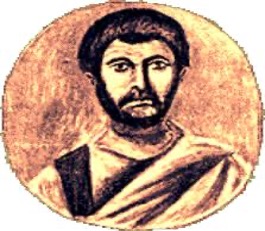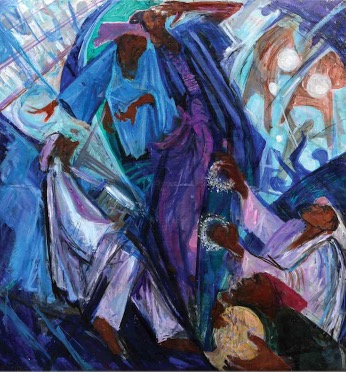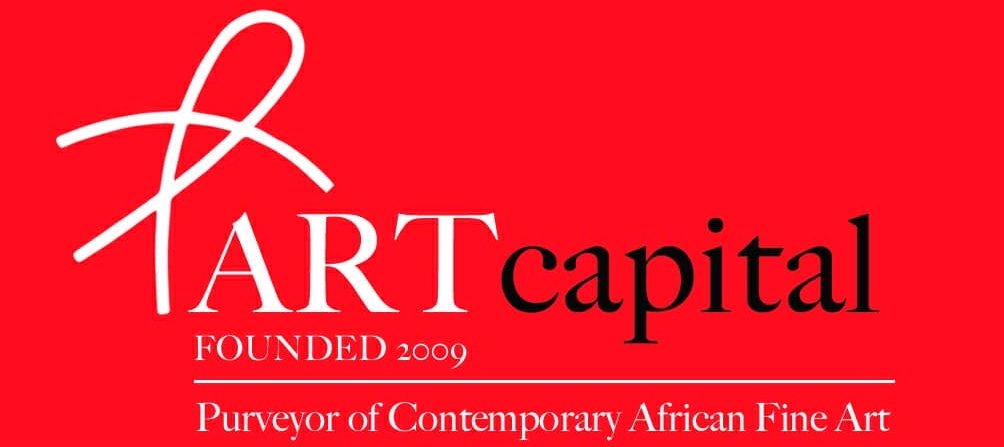By Nii B. Andrews.
The concept of cosmopolitanism goes way back in human history even though in the recent past it has been challenged on several fronts.
Those who like Diogenes of Sinope and Socrates, ascribe to being “citizens of the world”, have been derided as; weak, rudderless and unanchored; the less than charitable have even questioned their patriotism and wondered when they will be packing their bags in order to take leave of their native land.
During intracountry discourse wherein ethnocentrism is usually not far off from a jingoistic nationalist fervor; some have had cause to describe those with a cosmopolitan perspective as confused or even as traitors.

Although a devout Muslim, Grillo installed many splendid stained glass designs in churches in Nigeria.
His works highlight more vigorous engagement with the blue, purple, and green palettes.****]
If you have the privilege of coming from and or live within one of the great urban centers of Africa – Accra, Lagos, Jburg, Cairo, Casa, Dakar, Nairobi; perhaps like the essayist, Addison, you will have at various times felt yourself as Ga, Dagomba, Asante, Ewe, Xhosa, Kikuyu, Greek, English, Yoruba, Danish, Indian or Lebanese.
In the immortal words of the Roman African playwright – Terence, “I am human, and I think nothing human is alien to me”, (“Homo sum, humani nihil a me alienum puto”)
Is cosmopolitanism not the essential ethos of Africa?
The preponderence of the evidence from an accurate portrayal of our history is that it certainly is.
When it comes to CAA; the “Natural Synthesis” is an artistic ideology (practised by groups of artists in many African countries and the diaspora), that defined modern African art as a welding of the old and the new.

[******When describing his Afrofuturistic work, Macharia stated that “it is a post-colonial narrative about the continents, where you embrace history, present culture, and future aspirations of the people of Africa and its diaspora through art… music… fashion – and just tell a different narrative about the continent.”******courtesy Zeitz MOCCA].
The old was the indigenous cultural artistic practices of Africa, while the new included the Eurocentric stylistic variables promoted by the West and other genres especially during the colonial years of the 20th century.
Many recent African masters have excelled at this practice and produced seminal artwork; they include Hamri, Bucknor, Bogossian, Enwonwu and the recently departed giant educator and creative genius- Yusuf Grillo.

Our artists in this regard, are way ahead of the unseeming alliance of brownnosers, zounderkites and poliTRIKcians.
This latter cohort has insisted on establishing a different peculiarity in order to justify the defanging of our institutions, the callous jettisoning of modern progressive ideas and the unbridled promotion of a singular mediocrity leading to perennial national incoordination and underperformance.
A continuation of their cynical insular nativist narrative and convoluted reasoning will not wash. What really is an African problem; what at all is an African solution?
Today, West Africa is home to some of the most dysfunctional states on earth.
The region is rich in manifold resources, but many of the countries are the poorest on the planet in terms of the standard of living; and at this time, there is no credible plan to effect lasting positive change.

[****In this portrait, we see two young Yoruba women, Ayi and Tayi. They are wearing traditional gele aka exuberant headties.
Their figures are composed from overlapping, angular geometric planes.
The fragmentation references the work of European avant garde modernists like Picasso or Braque, but it also echoes the ancient tradition of Yoruba sculpture.****]

It is true that, “No where cool”; this is frequently parroted by many smug and conniving visages as a response to worsening social conditions and serious governance lapses.
Even more ubiquitous is the often nasally intoned hardly thought through snide rebuttal to fair critique, “Are you not a ghanaian?”, as if that is enough reason to abandon or water down your cognitive powers.
But for how long will these lame comments serve as an excuse for tomfoolery, murderous inefficiency, kleptocracy and the naked abuse of power?

By combining disparate traditions in an astute/intelligent manner as our major artists have done; we shall be able to create something new and beautiful.
Cosmopolitanism is about transcending the local and being open to the larger world, so that we may find a greater truth (or, in this case, beauty) just as Grillo relentlessly produced in his work and as did Terence in his plays.
Definitely, a fine dose of cosmopolitanism among the “ruling elite” should help us to effect a “Natural Synthesis”; to recalibrate and reposition our society along the path of Freedom and Justice.
The alternative is unthinkable.

Thank you for this. As usual the art work is magnificent .I love the colours.
As for your erudite text, how well it resonates! I think that the next time someone silly who thinks he/she is “more Ghanaian” than everybody else annoyingly asks me for the umpteenth time :
“Are you not Ghanaian?”, I am going to give him a sarcastic answer and say “NO”.
If his/her shocked countenance then makes it necessary for me to explain my answer, I will say sarcastically again (perhaps rudely ) : “I am not a Ghanaian because a ‘good Ghanaian’ is determined that his /her country does not progress in the same direction as the rest of the world “.
I find that such people who are not only tiring and irritants to one’s soul, but that they are actually hold back the progress and blooming of their country.
Have a nice “Ghanaian ” day😆
Always grateful for the feedback CA
Have a wonderful day.